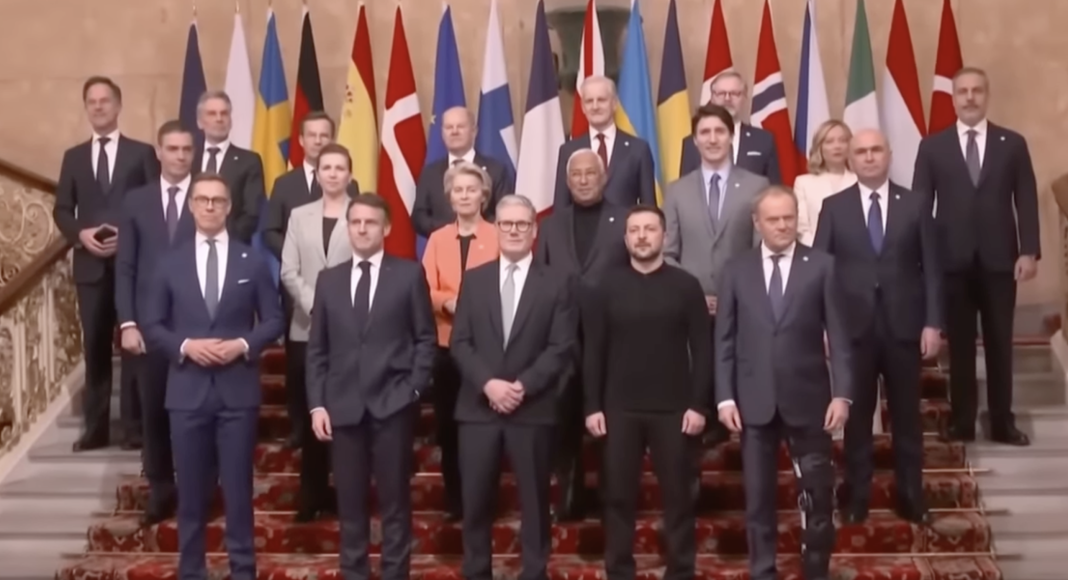Since negotiations began in February 2025, US imperialism continues to lead efforts towards a settlement of NATO’s proxy war against Russia in Ukraine. Three months of tentative negotiations have exposed major divisions between US and European imperialism as they fight over the spoils in Ukraine. At stake are potentially vast reserves of critical minerals and rare earth metals, control over which is vital for competing imperialist powers. Far from any concern over defending sovereignty, the ongoing negotiations are exposing the true essence of the conflict: another war to redivide the world. GEORGE O’CONNELL reports.
War by other means
On 16 May Ukraine and Russia met in Istanbul for their first direct talks since March 2022, shortly after the Russian invasion. This followed an unsuccessful attempt by the Western imperialists to impose a 30-day ceasefire on 12 May, on the back of similarly unsuccessful attempts at shorter ceasefires in the preceding weeks.
The talks in Istanbul, with Putin notably absent, achieved little. Russia demanded a Ukrainian withdrawal from and ceding of Luhansk, Donetsk, Zaporizhzhia, and Kherson, all mostly controlled by Russia, and Crimea, a historic Russian territory. Russian military advances have slowed in recent months, down from some 700sq km in November 2024 to 200 in April 2025, according to the British Ministry of Defence. However, Russia still maintains a relatively favourable military situation, emboldening its demands and giving it less incentive to pause the fighting. Meanwhile, Ukraine’s theatrical incursion into Kursk has been fully repelled, with a disastrous retreat under heavy fire in March.
As such, pursuing a settlement requires incentivising Russia. US imperialism is thus pressuring Ukraine to concede territory. On 28 April, US President Donald Trump alluded to forcing Ukraine essentially to relinquish its claim over Crimea. On 1 May US envoy Keith Kellogg told Fox News that Ukraine is ‘willing to give up the land, not forever but de facto’. Both statements indicate a reversal of previous US, NATO, and Ukrainian commitments to continue the war until all pre-2014 Ukrainian territory is recaptured.
Mineral wars
On 1 May Ukraine signed a minerals deal with the US, granting it preferential access to Ukrainian minerals, oil and natural gas, much to the dismay of European imperialism, which also has its sights on Ukraine’s resources. Ukraine claims to possess 5% of the world’s mineral deposits, including 22 of the 34 minerals designated as ‘critical’ by the EU. The deal is a watered-down version of the one tabled by Trump in February, which would have seen Ukraine raise $500bn from mineral sales to repay US military support. The deal will create a US-led joint investment fund for new ventures extracting Ukrainian minerals and fossil fuels.
Such extractive operations are hugely capital intensive, and the global average timescale for establishing a mine is 18 years. The deal thus aims to create a preferential investment environment for the US monopolies fronting the capital: it includes a clause barring Ukraine from imposing any tariffs or other barriers on the US. In the event of a continuation of the war, US arms to Ukraine will count as contributions to the joint fund, entitling the US to a greater share of the profits.
Ukraine’s potentially vast mineral and natural resource reserves are an immense opportunity for US imperialism. Critical minerals, including graphite, titanium, lithium, cobalt and rare earth elements, all potentially available in Ukraine, have wide applications in production of high-tech consumer goods, green technologies, and military hardware. Extraction of such finite natural resources, as well as fossil fuels, provide monopoly profits for the imperialist multinationals.
Domination over regions rich in such resources is a central aim of the imperialist states. This is a naked goal of the Trump administration, which has taken aim at three such regions: Ukraine, Greenland, and Canada. It also provides a means for combatting China’s industrial and technological strength. Currently China has a global monopoly on rare earth metals, accounting for 60% of worldwide production and 85% of processing capacity. Amidst escalating economic and political rivalry with China, the Western imperialists are desperate to break that dependency. In 2020, Republican Senator Ted Cruz wrote in an op-ed for Washington based newspaper The Hill:
‘At any time, China could cut off our access to rare earth elements and critical minerals. We need to act now to establish a critical mineral supply chain in the United States […] Our national security depends on it.’
On 4 April, China imposed export controls on 17 critical minerals as part of its escalating tariff war with the US.
European imperialism’s crisis
European imperialism also wants its share of Ukraine’s deposits, placing it in direct competition with US imperialism. This was made explicit by a 19 March EU Parliament report titled ‘The future of rare earths mining in Ukraine’. Its summary reads:
‘The US Trump administration has set its sights on Ukraine’s vast mineral resources, and proposed a deal: to secure a portion of Ukraine’s rare earths in exchange for US support in the war against the Russian aggressor. Ukraine is a candidate for EU membership, and an earlier 2021 strategic partnership means the EU also has a stake in the future of Ukraine’s mineral sector.’
On 25 March, announcing 47 new strategic metal production projects across 13 member states, EU industry commissioner Stephane Sejourne set out the stakes: ‘There can be no defence industry without rare earths, which are used in our radars, sonars and targeting systems – and for which we are 100% dependent on refined Chinese materials.’
This competition between US and European imperialism to carve up Ukraine shapes their respective political approaches to the negotiations. With US imperialism in pole position as signified by the minerals deal, European leaders increasingly see a continuation of the war as necessary to prevent being cut out of a settlement. Pressure from Europe forced an insertion into the US minerals deal that ensures it will not conflict with Ukraine’s potential obligations for EU membership.
On 12 May foreign ministers from Britain, France, Spain, Germany, Italy and the European Commission met in London and publicly stated that Russia must agree to the 30-day ceasefire before further negotiations can take place. This was an attempt to halt the negotiations in Istanbul, which Trump insisted should go ahead despite Russia’s rejection of the ceasefire.
NATO divisions
There is now a growing divergence between US and European imperialism in their approach to imperialist rival Russia, catalysed by the war in Ukraine. For US imperialism, China is the ultimate enemy, and yet the war and sanctions against Russia have pushed the two into a strategic partnership. A continuation of the war risks this developing further. Now, the US aims for a rapprochement with Russia to break it away from China. A continued US military presence in Europe at current levels is at odds with these aims.
European imperialism, on the other hand, is situated more closely to Russia. It sees Russia’s influence in several European countries as a threat. The strength of the European imperialist bloc relies on the ability of its leading imperialist powers, especially France and Germany, to consolidate political and economic power over the rest of Europe via the European Union. Recent elections in Romania, an EU member, and candidate states Georgia and Moldova, have been characterised by success for right-wing, Eurosceptic, Russia-aligned parties. Meanwhile, Russia-aligned EU member Hungary is able to exploit EU unanimity rules to veto and stunt policy decisions.
Importantly, the war and sanctions on Russia have severed Europe’s economic links with Russia, especially the dependence of the major European imperialists on imports of Russian natural resources. This has removed a previous check on hostility between European and Russian imperialism, for example in 2014 when France and Germany were reluctant to impose sanctions in response to the occupation of Crimea, despite US pressure. Now Russia is clearly cemented economically and politically as a rival to Europe.
This can be seen in the approach to a settlement. The last direct peace talks between Russia and Ukraine, also in Istanbul, took place in the two months following the invasion, February-April 2022. These were at the time supported by Europe and opposed by the US, who ultimately sabotaged them, aided by then British Prime Minister Boris Johnson’s visit to Ukraine in April 2022. Now, however, US imperialism leads the moves towards a settlement, and European imperialism is escalating and prolonging the conflict, under the spurious cover of concern for Ukrainian sovereignty.
On 15 April incoming German Chancellor Friedrich Merz signalled an intention to supply Ukraine with German Taurus long-range missiles. These are more advanced than US, British, and French supplied missiles, with a longer 500km range and a greater ability to evade missile defence systems. Their use would require German specialists. Merz’s predecessor repeatedly ignored Ukrainian demands for Taurus missiles over concerns of majorly escalating the conflict. Merz explicitly cited the Kerch bridge, linking Crimea to Russia, as a target. This is another drastic escalation towards direct confrontation between Russia and a NATO member. It expresses the aggressive drive for European imperialism to assert its interests by escalating and prolonging the war.
Labour: an imperialist party
On 10 May Britain’s Prime Minister Keir Starmer joined the leaders of France, Germany and Poland to meet with Ukrainian President Zelensky in Kiev. These are the three EU states most aggressively supporting escalation against Russia. Together with Britain they make up the so-called ‘coalition of the willing’, a grouping announced by Starmer on 2 March aimed at protecting the respective interests of British and European imperialism in the negotiations, whilst at the same time preparing to play a leading role in the event of a continuation of the war. They aim to establish a military presence in Ukraine and Eastern Europe, led by French and British troops.
Prior to Brexit, British imperialism historically sought to exploit its position between US and Europe. The imperialist Labour government sees the divisions as a fresh opportunity to do so.
British imperialism has its own interests in Ukraine, and is using a partnership with European imperialism to assert them amidst the aggressive US approach. On 15 January, Britain signed a ‘100 year partnership’ with Ukraine, with the aim of establishing Britain ‘as a preferred partner for Ukraine’s energy sector, critical minerals strategy and green steel production.’ On 26 March 2024, Conservative ministers met major Ukrainian investment company BGV group to discuss opportunities in Ukraine’s mining sector. A report of the meeting stated: ‘Ukraine has all the prerequisites to become one of Britain’s main suppliers of critical minerals crucial for advanced technologies.
The liberal press in Britain spills ink and crocodile tears over the destruction of Ukraine and the slaughter of tens or hundreds of thousands of Ukrainians. The reality is that the war is a significant opportunity for British imperialism. Meanwhile, the imperialist Labour government is determined to drive up arms spending, up to 2.5% of GDP from April 2027 and then 3%, to defend Britain’s imperialist interests as the crisis deepens.
Imperialist hands off eastern Europe!
FIGHT RACISM! FIGHT IMPERIALISM! 306 June/July 2025




